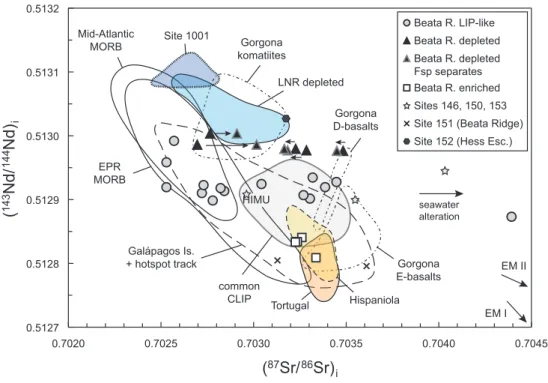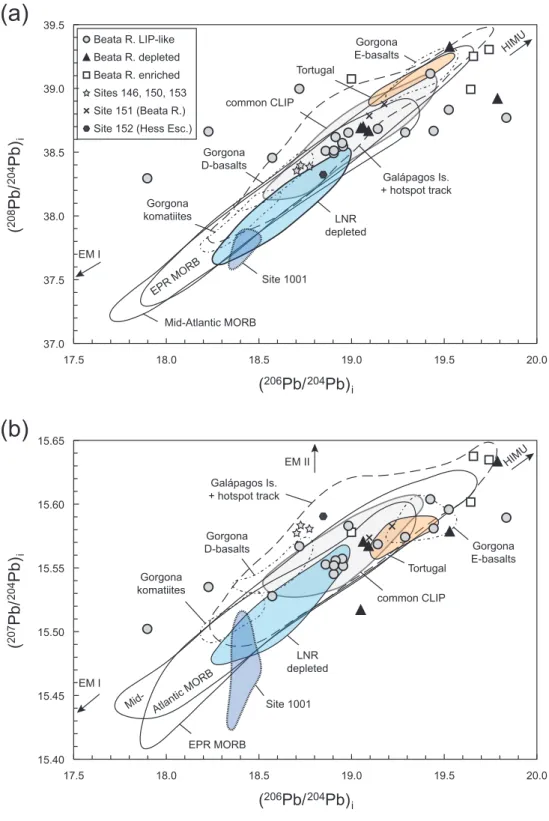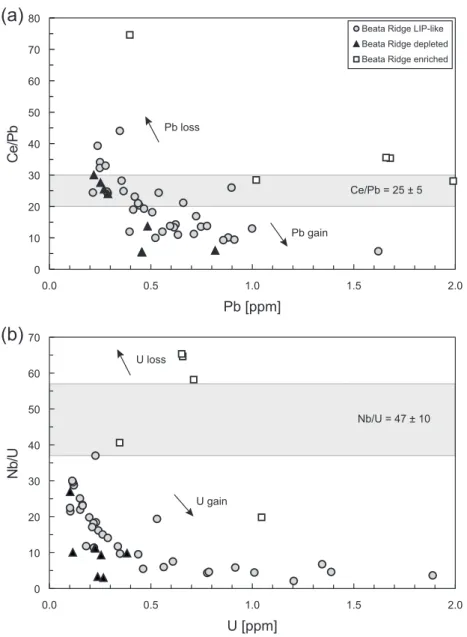Appendix C: Calculation of initial isotopic compositions and diagrams illustrating alteration effects.
Initial isotopic compositions for our samples were calculated using the 40Ar/39Ar ages determined in this study and an age of 85 Ma is assumed for samples where age data are not available. The reference data were also projected to a common age of 85 Ma to be able to compare them with our data. Exceptions are reference data, which are significantly younger (<50 Ma old) than the samples from the main CLIP phases, namely data of the Galápagos Islands and the younger Galápagos hotspot track. Since melting and differentiation processes can fractionate the parent/daughter ratios of the source, measured ratios cannot be applied to project the isotope ratios of these young rock samples correctly.
Thus we assumed proposed source parent/daughter ratios for average depleted MORB mantle (DMM) from Workman and Hart (2005) for the Atlantic and Pacific MORB fields and for the depleted eastern domain of the Galápagos Islands with the following trace element concentrations in ppm: Pb = 0.018, U = 0.0032, Th = 0.0079, Rb = 0.05, Sr = 7.664, Sm = 0.239, Nd = 0.581, Lu = 0.058, Hf = 0.157. For the three more enriched domains, we used the concentrations in ppm for bulk subducted igneous crust from Stracke et al. (2003): Pb = 0.09, U = 0.027, Th = 0.088, Rb = 0.57, Sr = 81, Sm = 2.69, Nd = 7.45, Lu = 0.45, Hf = 1.78.
For the Galápagos hotspot track, initial isotope ratios were first calculated using measured trace element concentrations and their ages and then projected to 85 Ma using the source parent/daughter ratios from Workman and Hart (2005) for tholeiites and those from Stracke et al. (2003) for alkali basalts.
Fig. C.1. Initial 87Sr/86Sr versus 143Nd/144Nd diagram. Although many of the samples from the LIP-like and from the depleted group are shifted to higher 87Sr86Sr ratios, the division into the three distinct groups is visible. For the depleted group, Sr isotope data from whole rock samples as well as from plagioclase separates are shown. Data from DSDP Leg 15, Sites 146 and 150-153 are also included (Hauff et al., 2000a). Additionally shown are fields for common CLIP (Hastie et al., 2016; Hastie et al., 2008; Hauff et al., 2000a; Hauff et al., 2000b; Hoernle et al., 2004; White et al., 1999), Hispaniola (Escuder-Viruete et al., 2007;
Lapierre et al., 1999; Lapierre et al., 1997), Tortugal (Hauff et al., 2000b; Trela et al., 2017), ODP Leg 165 Site 1001 (Kerr et al., 2009), depleted samples from the Lower Nicaraguan Rise (LNR; Dürkefälden et al., accepted), Galápagos Islands (Is.) (Blichert‐Toft and White, 2001; White et al., 1993; GEOROC at http://georoc.mpch.gwdg.de/georoc/) and Galápagos hotspot track (Hauff et al., 2000a; Hauff et al., 2000b; Hoernle et al., 2002; Trela et al., 2015) and for Gorgona komatiites, depleted (D-) and enriched (E-)basalts (Aitken and Echeverría, 1984; Révillon et al., 2000; Révillon et al., 2002; Serrano et al., 2011). The Mid-Atlantic and East Pacific Rise (EPR) MORB fields comprise data from the PetDB database (http://www.earthchem.org/petdb). Initial isotopic compositions are calculated at 85 Ma.
Analytical errors are smaller than the symbol size.
(143Nd/144Nd)i
0.5127 0.5128 0.5129 0.5130 0.5131 0.5132
(87Sr/86Sr)i
0.7020 0.7025 0.7030 0.7035 0.7040 0.7045
common CLIP Mid-Atlantic
MORB
EPR MORB
Galápagos Is.
+ hotspot track
Gorgona komatiites
Gorgona D-basalts
Gorgona E-basalts Tortugal Hispaniola
LNR depleted Site 1001
HIMU
EM II
EM I Site 152 (Hess Esc.) Site 151 (Beata Ridge) Sites 146, 150, 153 Beata R. enriched Beata R. depleted Fsp separates Beata R. depleted Beata R. LIP-like
seawater alteration
Fig. C.2. (a) Initial 206Pb/204Pb versus 208Pb/204Pb and (b) initial 206Pb/204Pb versus 207Pb/204Pb diagrams illustrating that the Pb isotope system is significantly affected by alteration processes. Data sources are the same as in Fig. C.1. Initial isotopic compositions are calculated at 85 Ma. Analytical errors are smaller than the symbol size.
(208Pb/204Pb)i
37.0 37.5 38.0 38.5 39.0 39.5
(206Pb/204Pb)i
17.5 18.0 18.5 19.0 19.5 20.0
HIMU
EM I
common CLIP
Mid-Atlantic MORB EPR MORB
Tortugal
Galápagos Is.
+ hotspot track Gorgona
komatiites
Gorgona D-basalts
Gorgona E-basalts
LNR depleted
Site 1001 Site 152 (Hess Esc.)
Site 151 (Beata R.) Sites 146, 150, 153 Beata R. enriched Beata R. depleted Beata R. LIP-like
(a)
(207Pb/204Pb)i
15.40 15.45 15.50 15.55 15.60 15.65
(206Pb/204Pb)i
17.5 18.0 18.5 19.0 19.5 20.0
EM II HIMU
EM I
common CLIP
Atlantic MORB Mid-
EPR MORB Galápagos Is.
+ hotspot track
Tortugal Gorgona
komatiites
Gorgona
D-basalts Gorgona
E-basalts
LNR depleted Site 1001
(b)
Fig. C.3. (a) Pb versus Ce/Pb diagram. The gray box shows a Ce/Pb ratio of 25 ± 5, which is typical for MORB and OIB (Hofmann et al., 1986), and the Pb concentrations of samples within this range are assumed to not have been significantly influenced by hydrothermal alteration. A few samples lie above this ratio and have lost Pb, whereas a large number of samples have Ce/Pb ratios lower than 20 and have gained Pb. (b) U versus Nb/U diagram demonstrating that most of the samples from the Beata Ridge are significantly affected by U gain during alteration processes. They lie below the Nb/U ratio of 47 ± 10 typical for MORB and OIB (gray box; Hofmann et al., 1986) and have high U concentrations.
Ce/Pb
0 10 20 30 40 50 60 70 80
Pb [ppm]
0.0 0.5 1.0 1.5 2.0
Ce/Pb = 25 ± 5 Beata Ridge enriched Beata Ridge depleted Beata Ridge LIP-like
Pb gain Pb loss
(a)
Nb/U
0 10 20 30 40 50 60 70
U [ppm]
0.0 0.5 1.0 1.5 2.0
Nb/U = 47 ± 10
(b)
U gain U loss
References
Aitken, B.G. and Echeverría, L.M., 1984. Petrology and geochemistry of komatiites and tholeiites from Gorgona Island, Colombia. Contributions to Mineralogy and Petrology 86, 94-105, 10.1007/bf00373714.
Blichert‐Toft, J. and White, W.M., 2001. Hf isotope geochemistry of the Galapagos Islands.
Geochemistry, Geophysics, Geosystems 2, doi:10.1029/2000GC000138.
Dürkefälden, A., Hoernle, K., Hauff, F., Werner, R. and Garbe-Schönberg, D., accepted.
Second-stage Caribbean Large Igneous Province volcanism: The depleted Icing on the enriched Cake. Chemical Geology.
Escuder-Viruete, J., Pérez-Estaún, A., Contreras, F., Joubert, M., Weis, D., Ullrich, T.D. and Spadea, P., 2007. Plume mantle source heterogeneity through time: Insights from the Duarte Complex, Hispaniola, northeastern Caribbean. Journal of Geophysical Research: Solid Earth 112, B04203, 10.1029/2006jb004323.
Hastie, A.R., Kerr, A.C., Mitchell, S.F. and Millar, I.L., 2008. Geochemistry and petrogenesis of Cretaceous oceanic plateau lavas in eastern Jamaica. Lithos 101, 323-343, http://www.sciencedirect.com/science/article/pii/S0024493707001764.
Hastie, A.R., Fitton, J.G., Kerr, A.C., McDonald, I., Schwindrofska, A. and Hoernle, K., 2016.
The composition of mantle plumes and the deep Earth. Earth and Planetary Science Letters 444, 13-25, http://dx.doi.org/10.1016/j.epsl.2016.03.023.
Hauff, F., Hoernle, K., Tilton, G., Graham, D.W. and Kerr, A.C., 2000a. Large volume recycling of oceanic lithosphere over short time scales: geochemical constraints from the Caribbean Large Igneous Province. Earth and Planetary Science Letters 174, 247-263, http://www.sciencedirect.com/science/article/pii/S0012821X99002721.
Hauff, F., Hoernle, K., van den Bogaard, P., Alvarado, G.E. and Garbe-Schönberg, D., 2000b. Age and geochemistry of basaltic complexes in western Costa Rica:
Contributions to the geotectonic evolution of Central America. Geochem. Geophys.
Geosyst. 1, 1-41, 10.1029/1999gc000020.
Hoernle, K., van den Bogaard, P., Werner, R., Lissinna, B., Hauff, F., Alvarado, G. and Garbe-Schönberg, D., 2002. Missing history (16-71 Ma) of the Galápagos hotspot:
Implications for the tectonic and biological evolution of the Americas. Geology 30, 795-798, http://geology.gsapubs.org/content/30/9/795.abstract.
Hoernle, K., Hauff, F. and van den Bogaard, P., 2004. 70 m.y. history (139-69 Ma) for the Caribbean large igneous province. Geology 32, 697-700, http://geology.gsapubs.org/content/32/8/697.abstract.
Hofmann, A.W., Jochum, K.P., Seufert, M. and White, W.M., 1986. Nb and Pb in oceanic basalts: new constraints on mantle evolution. Earth and Planetary Science Letters 79, 33-45, http://dx.doi.org/10.1016/0012-821X(86)90038-5.
Kerr, A.C., Pearson, D.G. and Nowell, G.M., 2009. Magma source evolution beneath the Caribbean oceanic plateau: new insights from elemental and Sr-Nd-Pb-Hf isotopic studies of ODP Leg 165 Site 1001 basalts. Geological Society, London, Special Publications 328, 809-827, 10.1144/sp328.31.
Lapierre, H., Dupuis, V., Lépinay, B.M.d., Tardy, M., Ruíz, J., Maury, R.C., Hernandez, J.
and Loubet, M., 1997. Is the Lower Duarte Igneous Complex (Hispaniola) a Remnant of the Caribbean Plume-Generated Oceanic Plateau? The Journal of Geology 105, 111-120, 10.2307/30079889.
Lapierre, H., Dupuis, V., Lépinay, B.M.d., Bosch, D., Monié, P., Tardy, M., Maury, R.C., Hernandez, J., Polvé, M., Yeghicheyan, D. and Cotten, J., 1999. Late Jurassic Oceanic Crust and Upper Cretaceous Caribbean Plateau Picritic Basalts Exposed in the Duarte Igneous Complex, Hispaniola: A Reply. The Journal of Geology 107, 509- 512, 10.1086/314362.
Révillon, S., Arndt, N.T., Chauvel, C. and Hallot, E., 2000. Geochemical study of ultramafic volcanic and plutonic rocks from Gorgona Island, Colombia: the plumbing system of an oceanic plateau. Journal of Petrology 41, 1127-1153, 10.1093/petrology/41.7.1127.
Révillon, S., Chauvel, C., Arndt, N.T., Pik, R., Martineau, F., Fourcade, S. and Marty, B., 2002. Heterogeneity of the Caribbean plateau mantle source: Sr, O and He isotopic compositions of olivine and clinopyroxene from Gorgona Island. Earth and Planetary Science Letters 205, 91-106, http://www.sciencedirect.com/science/article/pii/
S0012821X02010038.
Serrano, L., Ferrari, L., Martínez, M.L., Petrone, C.M. and Jaramillo, C., 2011. An integrative geologic, geochronologic and geochemical study of Gorgona Island, Colombia:
Implications for the formation of the Caribbean Large Igneous Province. Earth and Planetary Science Letters 309, 324-336, http://www.sciencedirect.com/science/
article/pii/S0012821X11004262.
Stracke, A., Bizimis, M. and Salters, V.J.M., 2003. Recycling oceanic crust: Quantitative constraints. Geochemistry, Geophysics, Geosystems 4, 8003, 10.1029/2001gc000223.
Trela, J., Vidito, C., Gazel, E., Herzberg, C., Class, C., Whalen, W., Jicha, B., Bizimis, M. and Alvarado, G.E., 2015. Recycled crust in the Galápagos Plume source at 70 Ma:
Implications for plume evolution. Earth and Planetary Science Letters 425, 268-277, http://dx.doi.org/10.1016/j.epsl.2015.05.036.
Trela, J., Gazel, E., Sobolev, A.V., Moore, L., Bizimis, M., Jicha, B. and Batanova, V.G., 2017. The hottest lavas of the Phanerozoic and the survival of deep Archaean reservoirs. Nature Geoscience 10, 451-456, 10.1038/ngeo2954.
White, R.V., Tarney, J., Kerr, A.C., Saunders, A.D., Kempton, P.D., Pringle, M.S. and Klaver, G.T., 1999. Modification of an oceanic plateau, Aruba, Dutch Caribbean: Implications for the generation of continental crust. Lithos 46, 43-68, http://dx.doi.org/10.1016/S0024-4937(98)00061-9.
White, W.M., McBirney, A.R. and Duncan, R.A., 1993. Petrology and Geochemistry of the Galápagos Islands: Portrait of a Pathological Mantle Plume. J. Geophys. Res. 98, 19533-19563, 10.1029/93jb02018.
Workman, R.K. and Hart, S.R., 2005. Major and trace element composition of the depleted MORB mantle (DMM). Earth and Planetary Science Letters 231, 53-72, http://dx.doi.org/10.1016/j.epsl.2004.12.005.


